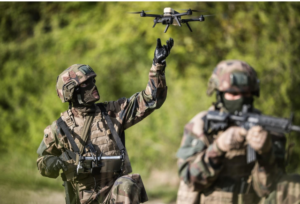
French drone company Novadem announced delivery this week of its latest model of micro-drone as the centerpiece of a $2.2 million contract with French armed forces.
The Ministère des Armées purchased 55 micro-drones from Novadem’s NX70 model line to provide security surveillance and reconnaissance over 24-hour periods.
“For several years, we have put in place all necessary processes and documentations to be able to face, when the day arrives, this increase of the production rate,” Novadem CEO Pascal Zunino. “This major contract has allowed us to refine and validate our organization in order to make it replicable in the future and to reach the quality standards expected by the [ministry].”
The contract includes training of more than a dozen users from France’s 61st Artillery Regiment with a total of 100 or more trained operators expected to be trained in the future.
Last year, Novadem introduced the first iteration of the NX70 under contract with France’s national police agency, Gendarmerie Nationale.
“Their feedback as well as feedback of other customers in France and abroad allowed us to continue research and development to develop the ‘Block 2’ model of today,” Zunino said. “This marks a new step compared to the first generation.”
Zunino added, the next generation of the NX70 drone improves image stabilization and night vision capabilities. “Radiofrequency links have also evolved to meet military requirements: defense frequency bands, data encryption and a radio range increased to more than 5 kilometers,” he added.
French defense officials tested the micro-drones in June at the Mourmelon military camp.
Earlier this year, Novadem launched a new tethered UAV platform, the NXWIRE 2.0 during AUVSI XPONENTIAL, the world’s largest UAS trade show. The drone model offers a ground-based power supply that can be connected to a main supply or auxiliary power unit and a 50-meter cable to sustain electrical power from the ground to the drone.
The company also produces LPS technology using terrestrial beacons much in the same way that GPS uses satellites to create a local positioning network.
Jason is a longstanding contributor to DroneLife with an avid interest in all things tech. He focuses on anti-drone technologies and the public safety sector; police, fire, and search and rescue.
Beginning his career as a journalist in 1996, Jason has since written and edited thousands of engaging news articles, blog posts, press releases and online content.
Email Jason
TWITTER:@JasonPReagan
Subscribe to DroneLife here.